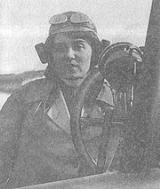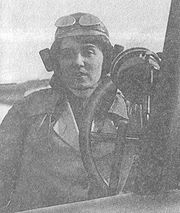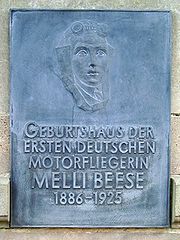
Amelie Beese
Encyclopedia

Dresden
Dresden is the capital city of the Free State of Saxony in Germany. It is situated in a valley on the River Elbe, near the Czech border. The Dresden conurbation is part of the Saxon Triangle metropolitan area....
, Saxony
Kingdom of Saxony
The Kingdom of Saxony , lasting between 1806 and 1918, was an independent member of a number of historical confederacies in Napoleonic through post-Napoleonic Germany. From 1871 it was part of the German Empire. It became a Free state in the era of Weimar Republic in 1918 after the end of World War...
.
Youth
In 1906 Beese decided to pursue a career as a sculptor; however, she had to leave her native GermanyGermany
Germany , officially the Federal Republic of Germany , is a federal parliamentary republic in Europe. The country consists of 16 states while the capital and largest city is Berlin. Germany covers an area of 357,021 km2 and has a largely temperate seasonal climate...
to study, as German art schools did not admit female students. She studied instead at Stockholm
Stockholm
Stockholm is the capital and the largest city of Sweden and constitutes the most populated urban area in Scandinavia. Stockholm is the most populous city in Sweden, with a population of 851,155 in the municipality , 1.37 million in the urban area , and around 2.1 million in the metropolitan area...
’s Royal Academy from 1906 until 1909. During this period, she learned to sail and developed an affinity for skiing. When she returned to Dresden in 1909 and she began studying mathematics, shipbuilding, and aeronautic engineering. It was during this period that she developed a desire to become a pilot.
Interest in aviation
In November 1910 she travelled to Johannisthal, the first airfield to open in BerlinBerlin
Berlin is the capital city of Germany and is one of the 16 states of Germany. With a population of 3.45 million people, Berlin is Germany's largest city. It is the second most populous city proper and the seventh most populous urban area in the European Union...
. Here she encountered early aviators from a variety of nations, and began to search for an instructor. In December of that year, Robert Thelens agreed to help her, but shortly thereafter he quit after Beese crashed a plane sustaining multiple injuries including broken ribs, nose and leg bones. In 1911, regulations pertaining to the flight test were made more stringent, and Beese, an inexperienced flier, found it increasingly difficult to persuade more experienced aviators to teach her.
Nevertheless, in May of that year she found a new instructor named von Mossner, who allowed her to take complete control of an aeroplane for the first time. Beese, encouraged by this, sought to gain more flying time, and spoke with the director of Johannisthal to this end. The director, Major von Tschudi, anticipated a stir in publicity if he allowed a female aviator to participate in the upcoming flight display, and so at the end of July 1911 Beese was allowed to fly unaided. She encountered several setbacks, including sabotage of her aircraft by other participating aviators. However, she did participate in the flight display, becoming the first female pilot in Germany on 13 September 1911.
Marriage and World War I
1912 was an eventful year for Beese. Following her father's death in January, Beese opened a flying school at Johannisthal airfield, with financial assistance from her mother. That same year she used her early training in architecture to design and patent a collapsible aircraft.She worked with one of her early pupils from her flying school, Charles Boutard, on plans for a flying boat. Her relationship with Boutard became close, and the two married in 1913. After marrying Boutard, Beese became a French citizen, thus making her ineligible to work on German airfields during the war. She was eventually arrested with her husband and tried as "undesirable aliens". Charles Boutard was interned and they moved to Wittstock for the duration of the war.
After the armistice between Germany and the allies was concluded, the Boutards filed suit on claims of compensation for goods confiscated upon Charles' internment. The lawsuits continued for most of the rest of her life, although the value of the claimed compensation decreased with the hyper-inflation that Germany suffered during the Weimar
Weimar Republic
The Weimar Republic is the name given by historians to the parliamentary republic established in 1919 in Germany to replace the imperial form of government...
period. Despite the troubles suffered due to the ongoing lawsuits and the economic troubles suffered throughout Germany, Melli planned to make a film documenting her flying. Some pieces were shot and still survive, and were included in a film made by Walter Jerven in 1940.
Death and legacy

Schmargendorf
Schmargendorf is a south-western locality of Berlin in the district of Charlottenburg-Wilmersdorf. Until 2001 it was part of the former district of Wilmersdorf.-History:...
. Also in 1925 Beese had an unfortunate accident, crashing the aeroplane she was flying when she reapplied for her pilot's license. On 22 December of that year, she shot herself in her Berlin flat. She is buried in the cemetery at Berlin-Schmargendorf. There is a small memorial park named after her in Wilmersdorf, at the corner of Storckwinkel- and Schwarzbacherstraße. In 1992, Straße 19 in Treptow was renamed Melli-Beese-Straße. Also, there is an exhibition dedicated to her in the Heimatmuseum in Treptow, in the eastern suburbs of Berlin. Johannisthal airfield, where she began her career as an aviator has now largely disappeared beneath the changing landscape of Berlin, and beyond street names in the area such as Pilotenstraße and Segelfliegerstraße there is no trace of it.

